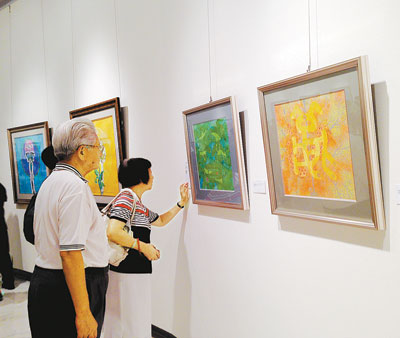|
Anna Zhao
anna.whizh@yahoo.com
MORE than 100 paintings by famed Chinese-American artist Lu Hong, also known by his Chinese name Ding Hong, are on display at the Guan Shanyue Art Museum through Aug. 3.
The paintings are on display for the first time on the Chinese mainland, although the artist’s works have been exhibited in Hong Kong, Taiwan, the United States, Canada, Japan, Singapore, France and the Netherlands.
The exhibits are characterized by surrealistic expressions of humans, animals and flowers that are easy to associate with ancient myths and religion. Although Lu lavishly uses bright colors in his paintings, they still seem to produce a feeling of serenity in viewers.
Lu said he doesn’t paint only specific subjects or use specific themes in his paintings, but he paints whatever inspires him, including music, literature, psychology, religion and legends. Some of his paintings have clearly been influenced by Picasso, especially the group of paintings called “Birth of Europe.”
As an artist with a Chinese background but who has lived abroad for more than two decades, Lu successfully developed his unique approach to art while freeing himself from the shackles of being defined by his culture. He was trained in traditional Chinese art, but learned to integrate both Asian and Western artistic traditions into his paintings to develop his own personal style.
Lu was born in 1959 into an intellectual family in Qinhuangdao, Hebei Province. He developed an interest in art during the Cultural Revolution since he couldn’t attend college to study his first two choices, psychology and archaeology. In 1979, he went to Yunnan Province to study painting under the tutelage of his uncle Ting Shaokuang, who is a respected leader in the world-renowned contemporary Chinese art movement known as the Yunnan School.
Yunnan in the 1980s was the cradle of contemporary Chinese art, and many talented young artists flocked there to sketch and exchange their views. The artistic environment there nurtured Lu’s artistic endeavors, though at that time he didn’t have a very strong interest in painting.
Lu said his knowledge of art was broadened by discussions and arguments with the other artists in the community who were highly influenced by Western art theories and works that flooded into China after the Cultural Revolution. Those artists emphasized individuality and influenced Lu to pursue his own artist ideals.
During his time in Yunnan, he tried his hand at different painting techniques; in particular, he was drawn to Western modern art. In 1981, the Central Academy of Design and Arts in Beijing, one of the top three Chinese art institutes, recruited him. He was soon dismissed, though, because of his rebellious views against the art orthodoxy of the school.
After leaving the school, Lu painfully struggled with his art, but he eventually found his way.

“I realized that modern art is about conveying an artistic concept to viewers through an artist’s individual expression. So I began to study how people communicate through art, from traditional art to contemporary expressions, from metaphysical symbols used in Asian art to the spirits and souls in Western art, from China’s ink and wash paintings to Western oil paintings, until my paintings gradually developed their own language,” Lu said recalling his life after he was expelled from school.
Lu moved to the United States in 1986 after he received a scholarship to the Pennsylvania Academy of Fine Arts. Art dealer Ron Segal developed an appreciation for Lu’s talent after seeing his paintings in Los Angeles in 1987. Segal presented Lu’s works in large art shows around the world.
Lu said life in the United States helped him see China from a new perspective. “You’ll love the culture where you’re from more when you live abroad,” he said. He also said life abroad allows an artist to be loyal to himself since he can work with fewer influences from market trends. “You soon realize that you can become the artist you want to be,” he explained.
Like other artists who have cross-cultural experiences, Lu said he soon faced the challenge of how to establish himself in the Western art world. After realizing that he couldn’t excel at Western modern art, he began to focus on researching what interested him — the cultures and religions of ancient Babylon, Greece, Egypt and India, and began experimenting with heavy color painting techniques he had learned in Yunnan.
He also tried to find a compromise between Asian art, which tends to be graphic, and Western art, which tends to be stereoscopic.
Even though it is clear that his art is heavily influenced by the West, his works also clearly reflect Chinese artistic traditions.
“My uncle used to tell me that ‘what is national is also international.’ Even though I live abroad, I want my paintings to retain Chinese elements, so I paint on paper, a medium of traditional Chinese painting, instead of on canvas,” Lu said. “I prefer the Asian philosophy that preaches inclusiveness in painting.”
In his opinion, too many Chinese artists are all the same. They try to cling too much to tradition. “Tradition should have its own life and adapt through time,” he said.
Lu returned to China in 2010. He said he is now adapting to a country that has changed so much over the last 20 years. He is also learning about folk art in China so he can incorporate it into his paintings.
Dates: Through Aug. 3
Hours: 10 a.m.-5 p.m., closed Mondays
Venue: Guan Shanyue Art Museum, Hongli Road, Futian District (福田区红荔路关山月美术馆)
Metro: Longhua or Longgang Line, Children’s Palace Station (少年宫站), Exit C
|

